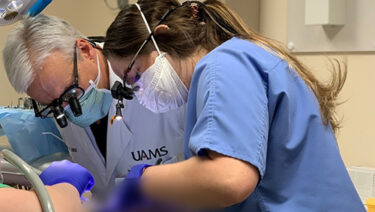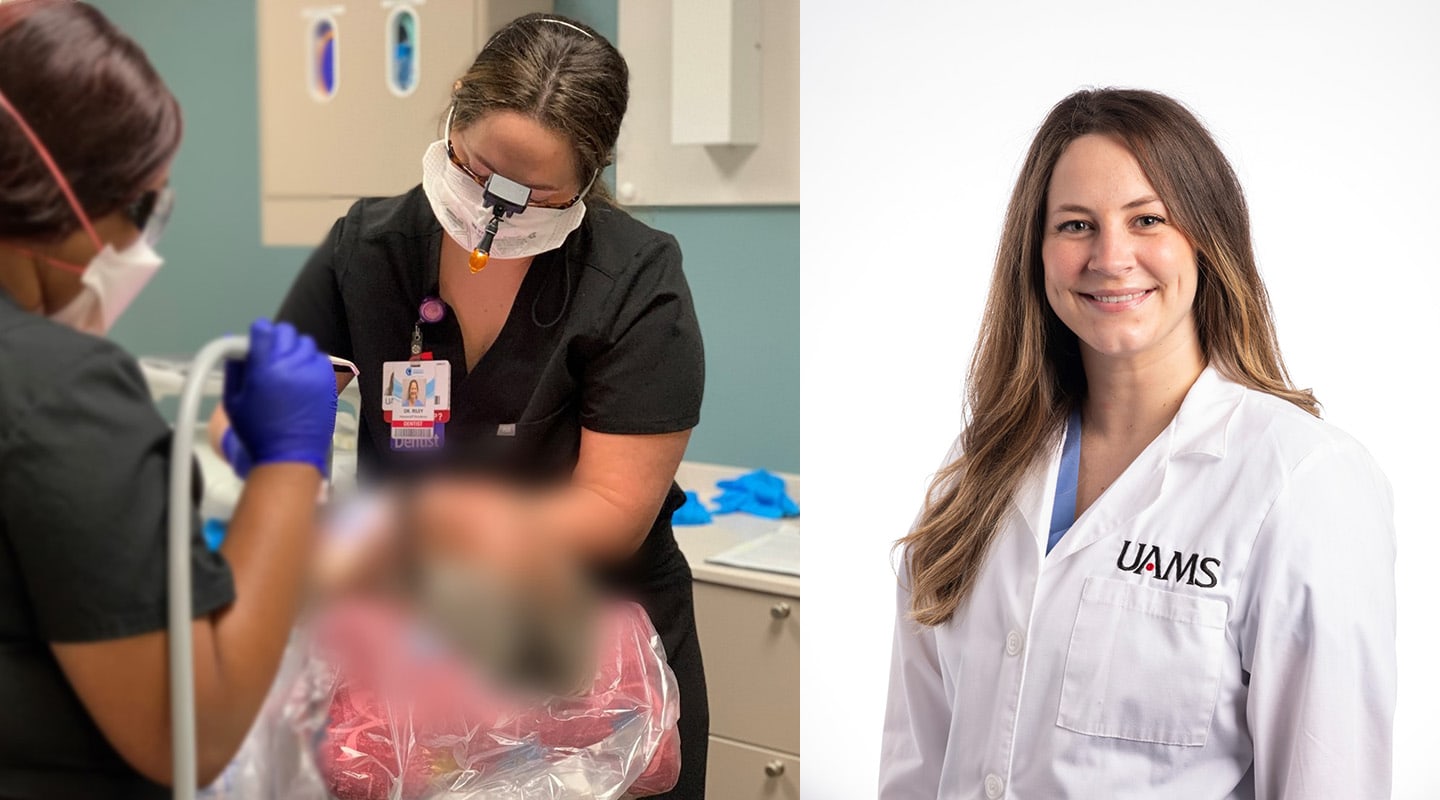UAMS General Practice Residency in Dentistry Continues to Grow, Educate
| Seven years after accepting its first residents, the residency program in the UAMS Center for Dental Education continues to provide one of the very few forums in Arkansas for training dentists.
Arkansas has no college or school of dentistry, and only one other dental residency program exists in the state. That program only has one position a year for a resident, while UAMS’s General Practice Residency (GPR) has six. The center and the program are both in the UAMS College of Health Professions.
The GPR recently added a position for a second-year residency and continues to develop a curriculum with training in the most up-to-date procedures and new technology.
“We’ve increased patient throughput, staff support, and invested in the latest dental technologies to be able to do more advanced procedures,” Ashley McMillan, DDS, said. “We just integrated digital scanners and are dipping our toes into digital dentistry.”
McMillan is especially well-qualified to comment on its growth because in 2015 she was one of the two first residents in the program. She now is the program’s director.
THE SECOND YEAR
Nakita Riley, DDS, this year is the first resident to take part in a second-year of the program. She said she was uncertain at first about whether she would be able to apply the knowledge gained in pursuing her degree into dental care for patients.

Nakita Riley, right, treats a patient with the assistance and supervision of R, Lee Hinson Jr., D.D.S.
The Delta Dental of Arkansas Foundation Oral Health Clinic on the Little Rock campus is one of the principal places in which Riley and other residents gain that hands-on experience. Although it remained open and operating during the pandemic unlike many private practices in central Arkansas, the disruptions COVID-19 caused around Riley’s training made her eager to seek more experience in a second year.
“The mentors I’ve found in this program’s full-time and adjunct faculty members have provided invaluable information. They’ve given me new perspectives on treatment planning, clinical techniques and more,” Riley said. “This past year, I have become a more confident, well-versed clinician, capable of planning and executing complex treatments to care for a diverse population, including medically complex patients.”
As a hospital-based program, residents in the Oral Health Clinic often treat medically compromised patients. They conduct inpatient consults, create treatment plans for medical clearance patients and communicate with physicians regarding mutual patient care. A dental-medical clearance is a determination by a dentist that a patient’s oral health is satisfactory for them to receive other medical treatment. Pathogens associated with dental disease can put some surgical and cancer patients at greater risk of infection and even death.
In addition to the medically compromised patient population, the OHC dental providers and their residents treat patients from the general public. In fact, a large number of UAMS employees have found their dental home in the OHC. Part of the program is not just to equip residents with the skills to treat patients but also the skills to be able to manage their own private practice, seek further specialty training, or find a career in academic dentistry. The UAMS Clinic is set up to create a private practice experience within a hospital setting to better prepare residents for “real world dentistry.”
In her second-year, Riley also spent considerable time in operating rooms where those surgeries take place.
“The OR has been such a unique learning space,” Riley said. “People often don’t realize how much dental services are involved in getting people approved for their life-saving medical procedures.”
She worked with Ear, Nose and Throat (ENT) specialists at UAMS and Arkansas Children’s Hospital. Oral surgeons also mentored Riley as she learned about reconstructive procedures for cancer patients, people injured in motor vehicle accidents and even congenital craniofacial disorders.
“The abundance of training and relationship building that has occurred elbow to elbow in the OR is something I will draw on every day in my future practice,” she said.
NET TECH
Doubtless, the future of dentistry will include increasing use of digital technology, and dental residents working in the Oral Health Clinic are learning how to use those new tools alongside their teachers.
In addition to UAMS and Arkansas Children’s Hospital, residents also see patients at the student-led UAMS 12th Street Health & Wellness Center and at the Harmony Health Clinic in Little Rock. The patient base of the Oral Health Clinic continues to expand, too.
“As for the program growth, just in the last three days we have had 12 inpatients,” McMillan said in late April. “We’ve never had that many. The hospital knows we’re here and are leaning on us more than they ever have. I think that’s a trendline, not an isolated spike.”
Robust patient volumes mean residents have more opportunities for hands-on learning and chances to care for an increasingly diverse client pool. They are acquiring skills faster, and McMillan said the center’s faculty have streamlined the curriculum and processes so residents can learn more efficiently.
Recently, the clinic purchased digital scanners, a new technology that records a high-resolution 3D image of a patient’s teeth and mouth. The scan provides data and precision measurements to be able to 3D print nightguards and implant guides, fabricate sleep and snore appliances, crowns and bridges, and many other applicationsThe data enables the dentists to avoid using what McMillan calls “impression goop,” molds and sometimes the multiple fittings and corrections that come with traditional methods.
The Oral Health Clinic has just started offering Invisalign, a series of multiple clear aligners that work similarly to traditional orthodontics to move teeth. Several residents and dentists practicing in the clinic have finished Invisalign training and the remainder will complete it soon.
FILLINGS
More than 30 residents have completed the program, and many of those have remained in Arkansas to practice. They are filling positions for dentists across the state including those in rural areas and small towns.
“Anecdotally, I get emails every week for dentists needed in the state of Arkansas,” McMillan said. “My residents are spoken for by January. They get offers of employment halfway through the program. I get emails from dentists needing an associate right away. The need is getting greater.”
She said one of the important goals of the program is to raise the skills of dentists in Arkansas and increase the size of the dental work force to elevate the standard of care in smaller communities.
By delivering a high quality of care to patients and training dentists to a higher level, the Center for Dental Education and the residency program have become widely known and built a positive, strong reputation.
“Our residents get more competitive employment contracts than their colleagues that didn’t do a general practice residency,” McMillan said. “Our residents are highly sought after in the state today. It took the program maturing and time before we earned that reputation in the community through word of mouth. Instead of ‘You did a GPR. That’s great.’ It’s now, ‘Oh, you did the UAMS GPR. That’s wonderful.’”
As the state has retained some of those residents and the program has increased its visibility, it’s built a network of its own. Adjunct, volunteer faculty from dentists in private practice are part of that network and play a vital role in the program.
The adjunct instructors provide clinical supervision of the residents and perform special procedures with them. McMillan said they free up faculty to see their own patients, and each resident in turn gets one-on-one attention. Adjunct faculty also lecture and make presentations to the residents.
“There is no way we could see patients, plan the program, innovate and be chairside all the time,” McMillan said. “Adjunct instructors also get some continuing education credits for doing those things, and that’s a plus for them, too.”
PROGNOSIS POSITIVE
Last year, the Department of Dental Hygiene moved the training for its students from a space adjacent to the Oral Health Clinic to a new, state-of-the-art Dental Hygiene Student Clinic in the Freeway Medical Tower near the Little Rock campus of UAMS. That move has freed up space for the Oral Health Clinic to expand.
McMillan said plans call for the remodeling of the old space to allow for additional individual rooms for the treatment of patients, also called operatories. The expansion will also provide additional office space and a conference room for resident lectures and patient case presentations.
What she and the College of Health Professions leadership hope to see in the future is more residency positions as well as the development of more specialty programs.
Just as McMillan was a resident and now is also an associate professor, McMillan said Riley has informally become a teacher, too.
Riley supervised some of the dental hygiene students for several clinical periods, including a clinic treating Afghan refugees and several community health events.
“Dr. McMillan also made me realize how much I helped the faculty through serving as a ‘chief resident’ and working through complex cases with the first-year residents,” Riley said. “I was able to handle a lot of their clinical software and EMR training because I had been there before, and I was in the workroom with them.”
Riley created an entire lecture on stem-cell transplant protocols for dental treatment. Its didactic component has been integrated into the training for all new incoming dental residents.
“Our mission is to take care of the medically compromised patients of Arkansas while simultaneously educating future dentists to take care of our community and its patient populations,” McMillan said.
Mission accomplished, and the mission continues.
